Click on images to enlarge
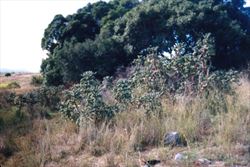
infestation (Photo: Land Protection, QDNRW)

infestation (Photo: Land Protection, QDNRW)
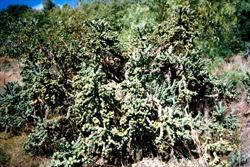
habit (Photo: Land Protection, QDNRW)
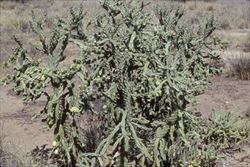
habit (Photo: David Albrecht)
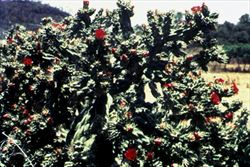
habit in flower (Photo: Land Protection, QDNRW)

habit in fruit (Photo: Land Protection, QDNRW)
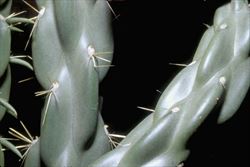
stem segments with raised humps and spines in clusters (Photo: David Albrecht)
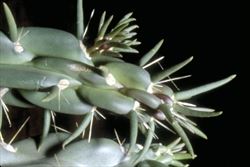
close-up of younger stems showing the cylindrical leaves, which are quickly shed (Photo: David Albrecht)

flowers (Photo: David Albrecht)

mature fruit (Photo: Land Protection, QDNRW)
Scientific Name
Cylindropuntia imbricata (Haw.) F.M. Knuth
Synonyms
Cactus imbricatus Haw.Cereus imbricatus Haw.Cylindropuntia imbricata (Haw.) F.M. Knuth var. imbricataOpuntia arborescens Engelm.Opuntia cylindrica auct. non (Lam.) DCOpuntia decipiens DC.Opuntia imbricata (Haw.) DC.Opuntia imbricata (Haw.) F.M. Knuth subsp. imbricata
Family
Cactaceae
Common Names
candelabrum cactus, cane cactus, cane cholla, chain link cactus, chain-link cactus, cholla, devil's rope, devil's rope pear, imbricate cactus, imbricate prickly pear, rope pear, tree cholla, walkingstick cholla
Origin
Native to southern USA (i.e. Kansas, Oklahoma, Colorado, New Mexico, Texas and Arizona) and northern Mexico.
Cultivation
Rope pear (Cylindropuntia imbricata) has been widely cultivated in the past, particularly in drier inland regions.
Naturalised Distribution
This species has a scattered distribution throughout the eastern parts of Australia. It is most common in the inland and sub-coastal regions of southern Queensland and New South Wales. Also recorded from north-western Victoria, south-eastern South Australia and the Northern Territory.
Also naturalised in eastern and southern Europe, northern and southern Africa and southern South America.
Habitat
This species is mostly found in semi-arid environments, but also occurs in drier sub-tropical and warmer temperate regions. It is a weed of roadsides, disturbed sites, pastures, open woodlands, rangelands and grasslands.
Habit
An upright (i.e. erect) or sprawling fleshy (i.e. succulent) plant. It usually grows 1-2 m tall, but occasionally reaches up to 3 m in height.
Distinguishing Features
- an upright or spreading fleshy plant (usually growing 1-2 m tall) with stems that consist of a series of cylindrical segments.
- these segments (up to 40 cm long and 3-5 cm thick) are covered in small humps that give them a rope-like appearance.
- its stem segments are also covered in groups of sharp spines (2-3 cm long).
- its showy purple or purplish-red coloured flowers (4-9 cm across) have large numbers of 'petals'.
- its fleshy fruit (25-70 mm long) turn yellow as they mature.
Stems and Leaves
Stems are much-branched, and consist of a series of hairless (i.e. glabrous), cylinder-like (i.e. sub-terete) segments that tend to hang downwards as they become older. These dull green or greyish-green coloured stem segments (30-40 cm long and 30-50 mm thick) have a series of short raised humps (i.e. tubercules), each 2-5 cm long, that give the stems a rope-like appearance. The stem segments also have small raised structures (i.e. areoles), most of which bear several (3-15) pale yellow or whitish-coloured barbed spines (20-30 mm long). The spines are partially covered in a papery sheath at first.
The small fleshy (i.e. succulent) leaves are cylindrical (i.e. terete) or cone-shaped (i.e. conical). These leaves (8-24 mm long) are quickly shed from the plant (i.e. they are caducous) and are often not present or readily apparent.
Flowers and Fruit
The showy purple or reddish-purple coloured flowers (up to 6 cm long and 3-9 cm across) are borne singly on a fleshy base towards the ends of the stem segments. They have large numbers of 'petals' (most of these are actually petal-like structures known as petaloids), each 15-35 mm long, and numerous yellow stamens. Flowering occurs mostly during late spring and summer.
Immature fruit are green in colour, but turn yellowish as they mature. These fruit (25-70 mm long and 20-40 mm wide) are fleshy (i.e. succulent), spineless, egg-shaped (i.e. obovoid) berries with deeply depressed tops. They are covered in small bumps (i.e. tubercules) and have 18-30 tiny raised structures (i.e. areoles). The seeds (2.5-4 mm long) are yellow to light brown in colour and sub-circular (i.e. sub-globose) or angular in shape.
Reproduction and Dispersal
This species reproduces by seed and vegetatively via stem fragments (i.e. stem segments may become dislodged and produce roots).
Stem fragments are spread by becoming attached to animals, footwear and vehicles. They may also be dispersed by flood waters and in dumped garden waste. The fruit are eaten by birds and other animals, and the seeds then spread in their droppings.
Environmental Impact
Rope pear (Cylindropuntia imbricata ) is regarded as an environmental weed in Queensland, and as a potential environmental weed in some other states. During recent surveys, it was listed as a priority environmental weed in two Natural Resource Management regions and was included among the top 200 invasive plants of south-eastern Queensland.
This cactus has the potential to become a widespread and abundant pest throughout inland Queensland, is common around mining settlements in the western areas of New South Wales, and is considered to pose a threat to semi-arid grasslands in Victoria.
Other Impacts
Rope pear (Cylindropuntia imbricata) is a very thorny cactus which can cause injury to humans and to animals. Infestations can reduce the livestock carrying capacity of pastures and can become thick enough to impede access.
Legislation
This species is declared under legislation in the following states and territories:
- New South Wales: Class 4 - a locally controlled weed. The growth and spread of this species
must be controlled according to the measures specified in a management plan
published by the local control authority and the plant may not be sold,
propagated or knowingly distributed (throughout the entire state).
- Northern Territory: B - spread to be controlled (south of 18°S latitude outside of town areas), and C - not to be introduced into the Territory. This species is declared under its old name (i.e. Opuntia imbricata) in the
Northern Territory.
- Queensland: Class 2 - landowners must take all reasonable steps to keep land free of this species (throughout the entire state). It is also illegal to sell a declared plant or its seed in this state.
- Western Australia: Unassessed - this species is declared in other states or territories and is prohibited until assessed via a weed risk assessment (throughout the entire state).
Management
For information on the management of this species see the following resources:
- the Biosecurity Queensland Fact Sheet on prickly pear identification and control, which is available online at http://www.dpi.qld.gov.au.
- the Northern Territory Department of Natural Resources, Environment and The Arts Agnote on this species, which is available online at http://www.nt.gov.au/weeds.
- the North West Weeds information page on this species, which is available online at http://www.northwestweeds.nsw.gov.au.
Similar Species
Rope pear (Cylindropuntia imbricata) is similar to snake cactus (Cylindropuntia spinosior), jumping cholla (Cylindropuntia prolifera), Hudson pear (Cylindropuntia rosea), thistle cholla (Cylindropuntia tunicata) and boxing glove cactus (Opuntia fulgida var. mamillata). It is also relatively similar to Harrisia cactus (Harrisia martinii) and tiger pear (Opuntia aurantiaca). These species can be distinguished by the following differences:
- rope pear (Cylindropuntia imbricata) is a short shrub (usually 1-2 m tall) with almost cylindrical (i.e. terete) stem segments that have numerous raised humps (2-5 cm long) and are rope-like in appearance. These stem segments have groups of 3-15 large whitish-coloured spines (2-3 cm long) on most of the small raised bumps (i.e. areoles) on their surfaces. Its flowers are reddish-purple in colour and its mature fruit are yellow.
- snake cactus (Cylindropuntia spinosior ) is a short shrub (0.5-2 m tall) with almost cylindrical (i.e. terete) stem segments that have numerous raised humps (0.5-1.5 cm long) and are rope-like in appearance. These stem segments have groups of 4-24 small whitish-coloured spines (1-2 cm long) on most of the small raised bumps (i.e. areoles) on their surfaces. Its flowers are red to reddish-purple in colour and its mature fruit are yellow.
- jumping cholla (Cylindropuntia prolifera ) is a short shrub (0.5-2.5 m tall) with almost cylindrical (i.e. terete) stem segments that have numerous raised humps (1.5-2.5 cm long) and are rope-like in appearance. These stem segments have groups of 6-12 relatively small brownish-coloured spines (up to 2 cm long) on most of the small raised bumps (i.e. areoles) on their surfaces. Its flowers are reddish-purple to pinkish-purple in colour and its mature fruit are greenish in colour.
- Hudson pear (Cylindropuntia rosea) is a short shrub (up to 1.5 m tall) with almost cylindrical (i.e. terete) stem segments that have numerous raised humps (up to 3 cm long) and are rope-like in appearance. These stem segments have groups of 4-8 large whitish-coloured spines (up to 4.5 cm long) on most of the small raised bumps (i.e. areoles) on their surfaces. Its flowers are reddish-pink or purplish in colour and its mature fruit are yellow.
- thistle cholla (Cylindropuntia tunicata) is a very short shrub (up to 0.6 m tall) with almost cylindrical (i.e. terete) stem segments that have numerous raised humps (2-3 cm long) and are rope-like in appearance. These stem segments have groups of 5-12 large yellowish-coloured spines (3-6 cm long) on most of the small raised bumps (i.e. areoles) on their surfaces. Its flowers are yellow in colour and its mature fruit are yellow or yellowish-green.
- boxing glove cactus (Cylindropuntia fulgida var. mamillata) is a short shrub (usually 1-2 m tall) with distorted stem segments that have numerous small raised humps and are broader towards the tips. These stem segments have groups of 0-18 small yellowish or whitish spines (up to 2 cm long) on some of the small raised bumps (i.e. areoles) on their surfaces. It usually does not produce flowers or fruit.
- Harrisia cactus (Harrisia martinii) is a low-growing plant (usually less than 1 m tall) with very long almost cylindrical (i.e. terete) stem segments that have numerous pyramid-shaped (i.e. pyramidal) humps. These stem segments have groups of spines (1 or 2 large spines and several much smaller ones) on most of the small raised bumps (i.e. areoles) on their surfaces. Its flowers are white or pinkish in colour and its mature fruit are bright red.
- tiger pear (Opuntia aurantiaca) it a low-growing plant (usually less than 40 cm tall) with relatively small rounded (i.e. terete) or slightly flattened stem segments that do not have any ridges or humps. These stem segments have groups of 1-7 large spines (1-3 cm long) on most of the small raised bumps (i.e. areoles) on their surfaces. Its flowers are yellow or pale yellow in colour and its mature fruit are reddish or purplish.

